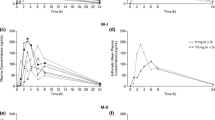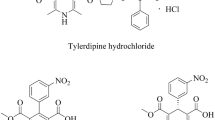Summary
The pharmacokinetics and beta-blocking effect of pindolol has been compared in 20 patients with essential hypertension (WHO Stage I), 10 below 25 years of age and 10 older than 60 years. Each patient received pindolol 10 mg p.o. once a day for 5 days.
The area under the curve (AUC) of pindolol was larger in the old than in the young patients both on the first (p<0.05) and the fifth (p<0.01) days. The AUC of pindolol was 14% higher on the fifth day compared to the first day in the elderly group, indicating minor accumulation at steady-state. There was no change in AUC in the young patients. Endogenous creatinine clearance was lower in the old (80±9 ml/min) than in the young patients (150±45 ml/min). The beta-blocking effect did not differ between the groups at 2h after administration of pindolol on Days 1 or 5. However, 24 h after the first and fifth doses approximately 60% of the beta-blockade persisted in the old group whereas 17 and 19% of the beta-blockade, respectively, persisted in the young group; the difference between the groups was statistically significant (p<0.01). The most probable explanation for the more sustained beta-blocking effect in the elderly is the physiologically decrease in renal function, which results in a more sustained plasma level of pindolol in those patients.
Similar content being viewed by others
References
Ishizaki T, Hirayama H, Tawara K, Nakaya H, Sato M, Sato K (1980) Pharmacokinetics and pharmacdynamics in young normal and elderly hypertensive subjects: A study using sotalol as a model drug. J Pharmacol Exp Ther 212: 173–181
Barber HE, Hawksworth GM, Petrie JC, Rigby JW, Robb OJ, Scott AK (1980) Pharmacokinetics of atenolol and propranolol in young and elderly subjects. Br J Clin Pharmacol 118P-119P
Rubin PC, Scott PJW, McLean K, Pearson A, Ross D, Reid JL (1982) Atenolol disposition in young and elderly subjects. Br J Clin Pharmacol 13: 235–237
Castleden CM, Kaye CM, Parsons RL (1975) The effect of age on plasma levels of propranolol and practolol in man. Br J Clin Pharmacol 2: 303–306
Castleden CM, George CF (1979) The effect of ageing on the hepatic clearance of propranolol. Br J Clin Pharmacol 7: 49–54
Schneider RE, Bishop H, Yates RA, Quarterman CP, Kendall MJ (1980) Effect of age on plasma propranolol levels. Br J Clin Pharmacol 10: 169–171
Quarterman CP, Kendall MJ, Jack DB (1981) The effect of age on the pharmacokinetics of metoprolol and its metabolites. Br J Clin Pharmacol 11: 287–294
Regårdh CG, Landahl S, Larsson M, Lundborg P, Steen B, Hoffmann KJ, Lagerström PO (1983) Pharmacokinetics of metoprolol and its metabolite α-OH-Metoprolol in healthy, non-smoking, elderly individuals. Eur J Clin Pharmacol 24: 221–226
Dillon N, Chung S, Kelly J, O'Malley K (1980) Age and beta-adrenoceptor-mediated function. Clin Pharmacol Ther 27: 769–772
Bühler FR, Kiowski W, van Brummelen P, Amann FW, Bertel O, Landmann R, Lütold BE, Bolli P (1980) Plasma catecholamines and cardiac, renal and peripheral vascular adrenoceptor-mediated responses in different age groups of normal and hypertensive subjects. Clin Exp Hypertens 2: 409–426
Vestal RE, Wood AJJ, Shand DG (1979) Reduced β-adrenoceptor sensitivity in the elderly. Clin Pharmacol Ther 26: 181–186
Schocken DD, Roth GS (1977) Reduced β-adrenergic receptor concentrations in ageing man. Nature 267: 856–858
Abrass IB, Scarpace PJ (1981) Human lymphocyte beta-adrenergic receptors are unaltered with age. J Gerontol 36: 298–301
Feldman RD, Limbird LE, Nadeau J, Robertson D, Wood AJJ (1984) Alterations in leukozyte β-receptor affinity with aging. A potential explanation for altered β-adrenergic sensitivy in the eldery. N Engl J Med 310: 815–819
Gugler R, Herold W, Dengler HJ (1974) Pharmacokinetics of pindolol in man. Eur J Clin Pharmacol 7: 17–24
Cockcroft DW, Gault MH (1976) Prediction of creatinine clearance from serum creatinine. Nephron 16: 31–41
Bangah M, Jackman G, Bobik A (1980) Determination of pindolol in human plasma by high performance liquid chromatography. J Chromatogr 183: 255–259
Sjöqvist F, Alván G (1983) Aging and drug disposition — metabolism. J Chron Dis 36: 31–37
Bobik A, Jennings G, Korner PI (1977) Plasma pindolol levels and their significance in the assessment of cardiac beta-blockade. Med J Aust Special 2 [Suppl]: 3–5
Jennings GL, Bobik A, Fagan ET, Korner PI (1979) Pindolol pharmacokinetics in relation to time course of inhibition of exercise tachycardia. Br J Clin Pharmacol 7: 245–256
Author information
Authors and Affiliations
Rights and permissions
About this article
Cite this article
Gretzer, I., Alván, G., Dunér, H. et al. Beta-blocking effect and pharmacokinetics of pindolol in young and elderly hypertensive patients. Eur J Clin Pharmacol 31, 415–418 (1986). https://doi.org/10.1007/BF00613516
Received:
Accepted:
Issue Date:
DOI: https://doi.org/10.1007/BF00613516




